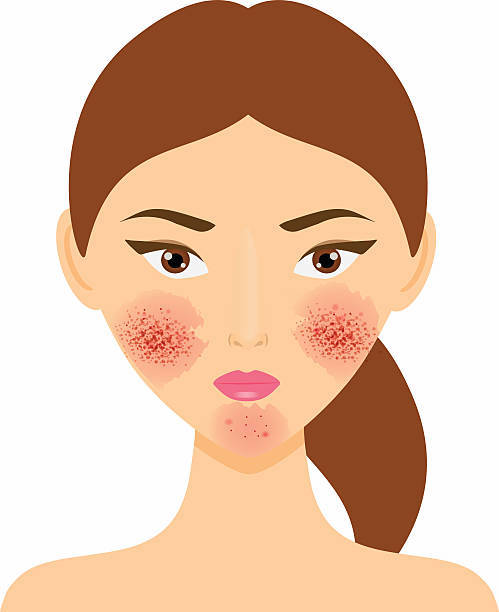Food as Medicine for Acne, Rosacea and Sensitive Pitta Skin
Acne can develop at any age, not just during adolescence. Hormones are not the sole factor at play. Our diet and eating habits also influence the condition of our skin. According to Ayurveda, acne, redness, or rosacea can be caused by an excess of the fire element in the body and mind, which is associated with the Pitta dosha, one of the three biological energies. Healthy Pitta skin is characterized by a rosy complexion and a beautiful glow, attributed to the fire element. It is also soft, moist, warm, and of medium thickness. However, when there is a Pitta imbalance in the skin, it can lead to various issues such as inflamed acne, rosacea, broken capillaries, excessive redness, burning eczema, psoriasis, burning eyes, extreme sensitivity, and very allergic skin.
Pitta energy comprises primarily of the fire element and a small amount of water. As a result, the energetic qualities of Pitta are hot, slightly moist, sharp, and comparatively light (although not as light as in Vata). When the fire of Pitta becomes uncontrolled, it leads to inflammation in the body. Initially, it accumulates in the liver, which is the primary organ of Pitta, and then it starts circulating through the blood vessels, ultimately settling down in different organs, including the skin. High Pitta affects all mucous membranes such as the stomach and intestinal lining, eyes, and blood vessel walls. The most common health issues associated with Pitta imbalance are liver problems, heartburn, gastric or peptic ulcers, acid reflux, fever, infection, loose stool, diarrhea, and the skin conditions mentioned earlier. On an emotional level, high Pitta can lead to anger, jealousy, criticism, and high intensity. If you are experiencing a few of these symptoms, it is time to start working on regulating the fiery energy of Pitta.
Ayurveda views the body as a whole, and thus, it teaches us that all imbalances in Pitta are associated with disturbances in the liver, gallbladder, and pancreas. These organs are akin to an "oven" in the body, where food is converted into energy. A helpful analogy for understanding this concept is that of a bonfire - if the fire is too intense, it can burn wood fast and fiercely, and everything around it. Similarly, it is crucial to regulate the intensity of Pitta by paying attention to the intake of foods and other substances that do not aggravate it. Uncontrolled Pitta energy is the underlying cause of inflammation in the body, including the skin. Therefore, it is necessary to maintain a balanced Pitta through a proper diet and lifestyle to avoid various health problems associated with Pitta imbalance.
Let us examine how the process of inflammation initiates and progresses in our body. When we consume an excessive amount of spicy, sour, or salty foods, it impairs digestion. Initially, it causes burning indigestion and heartburn, as these foods adversely impact the intestinal mucous lining. As a result, the stomach and small intestinal linings become inflamed, leading to inadequate production of digestive enzymes. Without enough digestive juices, the food we ingest cannot be digested correctly due to the lack of enzymes. Consequently, undigested food molecules, which are large in size because there are not enough enzymes to break them down, turn into toxins that start circulating throughout the body and settle in weaker organs.
In addition, chronic inflammation can lead to increased permeability of the intestinal walls, which can also cause toxicity and inflammation. The combination of toxins and the high fire of Pitta in the body leads to inflammation in various organs. It is well-known that inflammation is a root cause of many serious disorders.
Ayurveda offers a way to balance the hot, light, and sharp qualities of Pitta by using their opposite qualities: cold for hot, heavy for light, and dull for sharp. In Ayurveda, there are six tastes: sweet, salty, sour, bitter, astringent, and pungent. These tastes combine different elements and qualities. When we comprehend the qualities of all six tastes, we can use food as medicine to alleviate the symptoms of imbalanced Pitta and cool it down.
The best tastes for Pitta are sweet (not refined sugar), bitter, and astringent.
Sweet taste is made up of the earth and water elements. Thus, the sweet taste is heavy, moist, cool, smooth, soft, and nourishing. Pitta energy benefits the most from cool and soft qualities to calm and cool down Pitta's hot and sharp attributes. It is important to notice that refined sugar and a high dosage of natural sugars are not good for Pitta. Moreover, they seriously aggravate Pitta energy by creating inflammation in the body. And you know that Pitta is the energy causing any inflammation. Healthy examples of the sweet taste include most grains, white chicken and turkey meat, freshwater fish, sunflower seeds, coconut, ghee, olive oils, and non-fermented dairy. These foods are building blocks in the body and the skin. According to numerous studies, foods rich in Omega-3 are very beneficial for Pitta skin as Omega-3 is essential for creating a healthier skin barrier and fighting acne and rosacea, which are signs that Pitta energy went out of balance. You can buy supplements or be sure that you have enough omega-3 from your meals. The best vegetarian food choices containing Omega-3 for Pitta are walnuts, freshly ground flax seeds, hemp seeds, and chia seeds.
The bitter taste is a first aid when Pitta is very high. The bitter taste is made up of air and ether elements with qualities of coldness, lightness, mobility, and dryness. The bitter taste is the coldest among other tastes; thus, this taste is the best to counter the heat of elevated Pitta. So, almost all anti-inflammatory substances have a bitter taste. These substances clean the liver, improve bile flow, and clean blood vessels and blood, thus reducing inflammation. Bitter foods are our best choice when we need to work on inflamed acne lesions and any redness. The bitter taste is also drying, and this helps when acne skin is oily. However, when a person has a Vata-Pitta skin imbalance (dry, inflamed skin), too much bitter taste might aggravate acne. Examples of bitter taste include spinach, cilantro, kale, lettuce, and dandelion.
It's important to have a balanced diet that includes a variety of foods to provide all the necessary nutrients, vitamins, and minerals. While incorporating bitter taste is beneficial for balancing Pitta, excessive consumption can lead to the reduction of bodily tissues, making it not advisable for aging people as it can make the skin thinner and affect other bodily tissues. It's important to be reasonable and not rely solely on salads for balancing the bodily energies.
The astringent taste is made up of the earth and air elements; thus, its qualities are dry and cold, though it is not as dry and cold as the bitter taste. If you have a mixed Vata Pitta imbalance, be cautious. Too much astringent taste might aggravate the condition (similar to bitter taste). It happens because extreme dryness impairs all mucous membranes in the body eventually resulting in an impaired skin barrier, which is responsible for protecting the skin from bacteria. Again, the golden rule is moderation. Examples of the astringent taste include most beans, celery, cranberries and pomegranate.
Tastes that aggravate Pitta and should be reduced are pungent (hot), sour, and salty.
The pungent taste is made up of fire and air elements, and its qualities are hot, light, mobile, and dry. The pungent taste is the hottest among other tastes; thus, too much of hot spices will lead to inflammation in the gut. You have probably heard many times the expression “like likes like.” Through the Ayurvedic view, the doshas like their qualities and perpetuate them. Pitta dosha is made up of fire, and Pitta people love hot substances like ginger, garlic, chili, black pepper, onions, coffee, and alcohol. These ingredients burn stomach and small intestine linings, making them inflamed.
The sour taste is primarily made up of fire, earth elements, and a little water. These elements make the sour taste heavy and stable due to the earth element and hot and slightly moist due to the fire element. Too much sour taste increases Pitta, damages the small intestine, and results in hyperacidity. So, be diligent. Examples of the sour taste are sour fruits, sour tomatoes, fermented foods such as yogurt and kombucha, and wines.
The salty taste is primarily made up of water and fire elements. Due to this, the qualities of the salty taste are moist, warm, and relatively heavy (though not as heavy as the sweet taste). Seaweed, seafood, sea salts, and cottage cheese express the salty taste.
Among pungent, sour and salty tastes, pungent and sour are the most aggravating for Pitta.
We all have a unique proportion of all three doshas in our bodies, which is why we should aim to include all six tastes in our diet. The key is to consume more of the beneficial tastes and less of the vitiating ones. Although it is common for someone with a predominant Pitta dosha to experience primary Pitta imbalances, there are other scenarios to consider. For instance, when a person experiences significant stress or loss (such as a job or a loved one), Vata energy can become primary and mix with natural Pitta. Therefore, it is essential to not only address the Pitta imbalance but also keep Vata in balance. Doshas are in a constant state of change within the body and the environment. For instance, a summer day can be rainy and damp, indicating high Kapha, while another day can be hot and dry, resembling a desert, indicating high Pitta. A cold and dry winter day represents a Vata day.
Ayurveda identifies three seasons within a year: late fall to the first part of winter is a Vata season, the second part of winter and spring is a Kapha season, and summer to the beginning of fall is a Pitta season. Furthermore, there are three stages in human life: childhood and adolescence are the Kapha stage of life, adulthood (after 16 years) is a Pitta stage, and old age is the Vata stage.
It is an art to understand the qualities that affect you at every moment and strive to balance them accordingly.

